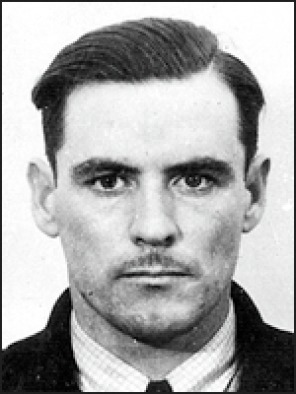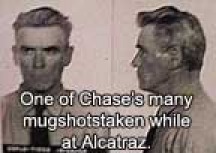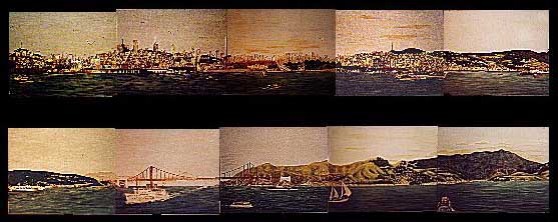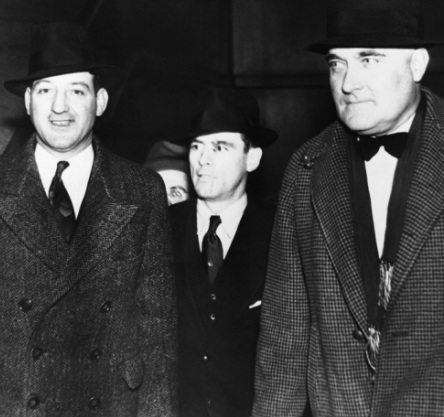This is a copy of one of John Paul Chase's many artworks. It consists of a series of panels producing a panorama of the San Francisco skyline, as seen from the art room at Alcatraz.
John Paul Chase
Bootlegger, thief, artist

John Paul Chase was born Dec. 26, 1901, in San Francisco. He was involved in crime from an early age, and first came to the attention of police as a minor bootlegger in San Francisco. He played small roles in a variety of crimes in California, both as a freelancer and as an associate of organized crime groups.
After his crime partner, George "Baby Face" Nelson died from wounds received in a gun battle with FBI agents, Chase helped dispose of the body and he and Nelson's wife, Helen Gillis, returned to Chicago where they went separate ways. Helen, alone and frightened, spent the night in an apartment house doorway. The next morning she turned herself into police and was arrested.
Chase went to a safe house to make plans to head west. On Nov. 30, 1934, he responded to a want ad seeking someone to drive an automobile to Seattle. Ironically, he was required to go to the police station to be photographed (photo above) for a chauffeur's license. Because Chase's only arrest was for public drunkenness in 1931, however, no wanted circulars with his photo or fingerprints had ever been issued.
In early December, the FBI's San Francisco office, betting Chase would try to return to California, contacted his former employers and associates. They were instructed to notify the FBI if Chase surfaced.
After his crime partner, George "Baby Face" Nelson died from wounds received in a gun battle with FBI agents, Chase helped dispose of the body and he and Nelson's wife, Helen Gillis, returned to Chicago where they went separate ways. Helen, alone and frightened, spent the night in an apartment house doorway. The next morning she turned herself into police and was arrested.
Chase went to a safe house to make plans to head west. On Nov. 30, 1934, he responded to a want ad seeking someone to drive an automobile to Seattle. Ironically, he was required to go to the police station to be photographed (photo above) for a chauffeur's license. Because Chase's only arrest was for public drunkenness in 1931, however, no wanted circulars with his photo or fingerprints had ever been issued.
In early December, the FBI's San Francisco office, betting Chase would try to return to California, contacted his former employers and associates. They were instructed to notify the FBI if Chase surfaced.
End of the line

The FBI's bet paid off. On Dec. 27, 1934, Chase approached employees at the Mount Shasta, Calif., fish hatcheries, where he had worked in 1928, trying to borrow money from a former co-worker. The FBI and local police were notified, and A.L. Roberts, the chief of police, arrested Chase without incident.
On Dec. 31, Chase was returned to Chicago where he was the first person to be tried under a new law that made it a federal offense to kill an agent while in the performance of his duties. On Feb. 19, 1935, Chase was arraigned before Judge Philip L. Sullivan in Chicago. He pleaded not guilty to two counts of murder in the deaths of Hollis and Cowley (see chapters on Nelson's death). Chase's trial began on March 18, 1935. On March 25 he was found guilty, but the jury recommended mercy. Judge Sullivan sentenced Chase to life in prison, and on March 31 Chase was transferred to Alcatraz (prisoner AZ-238). While there, Chase became an accomplished artist. Some of his artwork - including an impressive 10-panel panoramic view of the area surrounding Alcatraz - is displayed on the Alcatraz Homepage. (A thumbnail of it is pictured at the top of this page.)
On Dec. 31, Chase was returned to Chicago where he was the first person to be tried under a new law that made it a federal offense to kill an agent while in the performance of his duties. On Feb. 19, 1935, Chase was arraigned before Judge Philip L. Sullivan in Chicago. He pleaded not guilty to two counts of murder in the deaths of Hollis and Cowley (see chapters on Nelson's death). Chase's trial began on March 18, 1935. On March 25 he was found guilty, but the jury recommended mercy. Judge Sullivan sentenced Chase to life in prison, and on March 31 Chase was transferred to Alcatraz (prisoner AZ-238). While there, Chase became an accomplished artist. Some of his artwork - including an impressive 10-panel panoramic view of the area surrounding Alcatraz - is displayed on the Alcatraz Homepage. (A thumbnail of it is pictured at the top of this page.)
A life of art on 'The Rock'

In September, 1954, Chase was transferred to the U.S. Penitentiary at Leavenworth. Chase was beginning to hope for a parole, but he was still under indictment for his part in the murder of Agent Hollis. A motion was filed in U.S. District Court in Chicago demanding immediate trial on the indictment or its dismissal.
On Oct. 17, 1955, a U.S. District judge dismissed the indictment, ruling that Chase's knowledge of the indictment, and his failure to take action, did not constitute a waiver of his right to a speedy trial.
Dismissal of the indictment cleared the way for Chase to apply for parole. After repeated attempts, he was finally paroled on Oct. 31, 1966. He returned to California where he worked as a janitor for a little over six years, until illness forced him into a county hospital. While working, he lived in a small room at a private residential hotel.
Few of his neighbors were aware of his colorful past, only that he had spent many years in prison. He continued to paint in his free time, usually giving his works to anyone who showed an interest. He was described as quiet and friendly, but someone who kept to himself. It's not known, but considered very unlikely, he had any contact with Helen Gillis after the night Nelson died.
John Paul Chase died of colon cancer in Palo Alto, Calif., on Oct. 5, 1973, at the age of 71. He was buried there, his funeral attended by a small group of mourners. He still had a few surviving family members, but apparently none attended his burial.
On Oct. 17, 1955, a U.S. District judge dismissed the indictment, ruling that Chase's knowledge of the indictment, and his failure to take action, did not constitute a waiver of his right to a speedy trial.
Dismissal of the indictment cleared the way for Chase to apply for parole. After repeated attempts, he was finally paroled on Oct. 31, 1966. He returned to California where he worked as a janitor for a little over six years, until illness forced him into a county hospital. While working, he lived in a small room at a private residential hotel.
Few of his neighbors were aware of his colorful past, only that he had spent many years in prison. He continued to paint in his free time, usually giving his works to anyone who showed an interest. He was described as quiet and friendly, but someone who kept to himself. It's not known, but considered very unlikely, he had any contact with Helen Gillis after the night Nelson died.
John Paul Chase died of colon cancer in Palo Alto, Calif., on Oct. 5, 1973, at the age of 71. He was buried there, his funeral attended by a small group of mourners. He still had a few surviving family members, but apparently none attended his burial.









